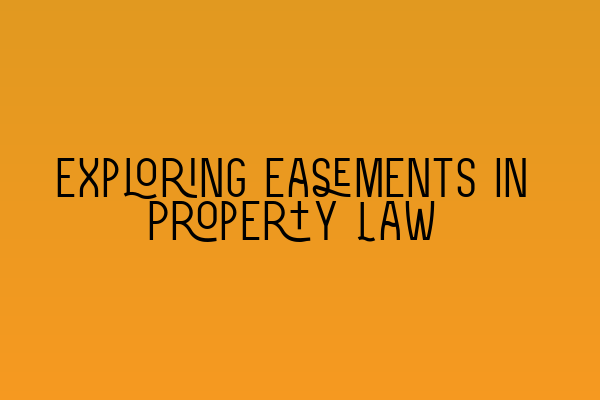Exploring Easements in Property Law
When it comes to property law, there are various legal rights and interests that individuals can hold in relation to land. One such interest is an easement, which grants a person the right to use another person’s land for a specific purpose. Understanding easements is crucial for both property owners and potential buyers, as they can have significant implications on the use and enjoyment of land.
What is an Easement?
An easement is a non-possessory right to use someone else’s land for a specific purpose. It essentially allows a person to perform certain actions on another person’s property without actually owning it. Common examples of easements include rights of way, which allow individuals to pass through another person’s land, and utility easements, which allow utility companies to access and maintain utility lines on private property.
Easements can be created in different ways. They may be expressly created through a written agreement between the parties involved, such as in a deed or contract. Easements can also be acquired through long-term use or necessity, known as implied easements. It is important to note that easements are legally binding and can run with the land, meaning they are attached to the property and transfer to subsequent owners.
The Importance of Easements
Easements serve an important function in property law by balancing the rights and interests of different individuals. They allow for the efficient use of land and promote access to essential services and amenities. For example, a right of way easement can provide necessary access to a landlocked property, ensuring that its owner can enter and exit their property with ease.
Furthermore, easements can impact property values and potential development. Buyers and developers must consider existing easements on a property when assessing its potential uses and limitations. Failure to properly account for easements can lead to legal disputes and complications down the line.
Types of Easements
There are several types of easements that can arise in property law. Understanding these different types can help individuals navigate legal issues and make informed decisions when it comes to land use. Some common types of easements include:
1. Right of Way Easements:
A right of way easement grants a person the right to travel across another person’s land to access their property. This type of easement is commonly used in situations where there is no direct access to a public road or to provide alternative access routes.
2. Utility Easements:
A utility easement allows utility companies, such as water, gas, or electricity providers, the right to access and maintain utility lines that run through private property. These easements are crucial for the delivery of essential services and are often created to ensure the efficient distribution of utilities.
3. Conservation Easements:
A conservation easement is a voluntary agreement between a landowner and a land trust or government agency. It restricts certain types of development or land use in order to preserve the property’s natural or ecological features. Conservation easements are often used to protect environmentally sensitive areas or historic properties.
4. View Easements:
A view easement grants a person the right to maintain a scenic view from their property, preventing the obstruction of their view by neighboring structures or vegetation. View easements are typically established to preserve the aesthetic quality of an area and can be beneficial in maintaining property values.
Enforcing and Terminating Easements
Enforcing or terminating an easement can be complex and may require legal intervention. If one party interferes with the rights granted by an easement, the affected party can seek legal remedies to enforce their rights. This may include seeking an injunction to prevent the interference or suing for damages.
Easements can also be terminated under certain circumstances. For example, if the easement was created for a specific purpose that is no longer relevant or if the dominant and servient properties are merged into one ownership. Termination may require mutual agreement, court intervention, or by the express terms outlined in the original easement agreement.
Conclusion
Easements play a vital role in property law, defining the rights and interests individuals hold in relation to land. Understanding the different types of easements and their implications is essential for property owners and potential buyers. By grasping the intricacies of easements, individuals can make informed decisions, avoid disputes, and ensure the smooth use and enjoyment of their property.
For more information on property law and other legal topics, check out our related articles:
